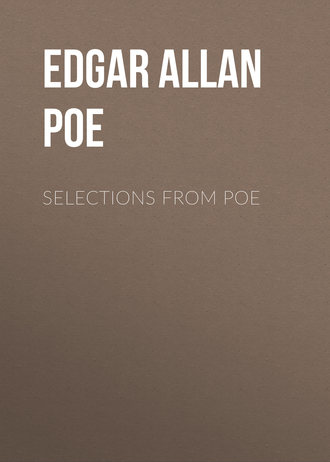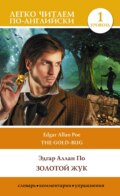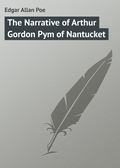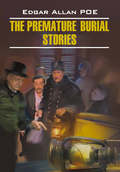
Эдгар Аллан По
Selections from Poe
NOTES
The text followed both for poems and tales is that of the Stedman-Woodberry edition of Poe's Works, in which the editors followed, in most cases, the text of what is known as the "Lorimer Graham" copy of the edition of 1845, containing marginal corrections in Poe's own hand. Poe revised his work frequently and sometimes extensively. The following notes show, in most cases, the dates both of the first publication and of subsequent ones. Familiarity with the Introduction to this book will, in some cases, be necessary to an understanding of the notes. Gayley's "Classic Myths in English Literature" (Ginn & Company, $1.50) is the best reference work of small size for allusions to mythology, and should be available.
Both poems and tales are arranged in chronological order.
POEMS
SONG (Page 3)
Published in 1827, 1829, and 1845. The poem is believed to refer to Miss Royster, of Richmond, with whom Poe was in love as a boy of sixteen, shortly before he entered the University of Virginia. The young lady's father intercepted the correspondence, and Miss Royster soon became Mrs. Shelton. The blush, mentioned in lines 2, 9, and 14, is doubtless intended to imply shame for her desertion. The poem is commonplace, and shows little that is characteristic of the older Poe.
SPIRITS OF THE DEAD (Page 3)
Published in 1827 as "Visit of the Dead," and in 1829 and 1839 under the above title. It has been conjectured that this poem was inspired by the death of Mrs. Stannard (see Introduction, page xii).
TO – (Page 4)
The original, longer and addressed "To M – ," appeared in the edition of 1829, and was republished in 1845.
ROMANCE (Page 5)
Printed as a preface in 1829, and as an introduction in 1831; considerably revised and shortened, it appeared in 1843 and 1845 as "Romance."
11. condor years. The metaphor implies a likeness of time – the years – to a bird of prey. Cf. "condor wings" in "The Conqueror Worm."
19. forbidden things: i.e. "lyre and rhyme." What is the meaning?
TO THE RIVER – (Page 5)
Published first in 1829, afterwards in several magazines and in the edition of 1845.
TO SCIENCE (Page 6)
Published first in 1829, this poem appeared in editions of 1831 and 1845, and in magazines. It is a sonnet, differing from the Shakespearean form only in the repetition of the rhyme with "eyes."
9, 10, 12. In classical mythology, Diana is the moon goddess, Hamadryad, a wood nymph, Naiad, a water nymph. Consult Gayley's "Classic Myths." Explain the figures of speech.
13. Elfin: elf, a fairy, from the Anglo-Saxon, refers especially to tiny sprites, fond of mischief and tricks. But there were various kinds of elves, according to the Norse mythology. Consult Gayley's "Classic Myths." Explain the figure.
14. tamarind-tree: a beautiful, spreading, Oriental tree, with pinnate leaves and showy racemes of yellow flowers variegated with red. What does the line mean?
TO HELEN (Page 7)
Published in 1831, 1836, 1841, 1843, and 1845. Read comment in the
Introduction, pages xii and xxiii.
2. Nicæan barks. It is impossible to say exactly what this allusion means. Professor W.P. Trent aptly suggests that if "wanderer" in line 4 refers to Ulysses, as seems likely, "Phæacian" would have been the right word, since the Phæacians did convey Ulysses to Ithaca. Poe may have had that idea in mind and used the wrong word, or this may simply be a characteristically vague suggestion of antiquity. Point out similar examples of indefinite suggestion in this poem.
7. hyacinth hair: a favorite term with Poe. In "The Assignation" he says of the Marchesa Aphrodite, "Her hair … clustered round and round her classical head, in curls like those of the young hyacinth." The hair of Ligeia, in the story of that title, he calls "the raven-black, the glossy, the luxuriant and naturally-curling tresses, setting forth the full force of the Homeric epithet, 'hyacinthine.'"
8. Naiad airs: suggestive of exquisite grace. The Naiads, in classical mythology, are water nymphs, – lovely maidens presiding over brooks and fountains.
9, 10. Two of Poe's best and most frequently quoted lines. Explain the fitness of the epithets. Originally the lines read:
To the beauty of fair Greece
And the grandeur of old Rome.
Is the change an improvement? Explain.
14. Psyche: the Greek word for "soul," and also the name of a beautiful maiden whom Cupid himself loved and wedded. Read the story in Gayley's "Classic Myths."
ISRAFEL (Page 7)
Published in editions of 1831 and 1845, and several times in magazines. See comment in the Introduction, page xxiii. Poe derived the quotation through Moore's "Lalla Rookh," altered it slightly, and interpolated the clause, "whose heart-strings are a lute"; it is from Sale's "Preliminary Discourse" to the Koran.
12. levin, or leven: an archaic word for "lightning."
13. Pleiads, or Pleiades: a group of stars in the constellation Taurus; only six stars of the group are readily visible, but legend tells of a seventh, lost. Read the account of the ancient myth in Gayley's "Classic Myths."
23. skies: the object of "trod."
26. Houri: derived from an Arabian word meaning "to have brilliant black eyes." It is the name in Mohammedan tradition for beautiful nymphs of Paradise, who are to be companions of the pious.
THE CITY IN THE SEA (Page 9)
Published in 1831 as "The Doomed City," in 1836 as "The City of Sin," and several times in 1845 under the above title.
Point out examples of alliteration.
18. Babylon-like walls. The walls of the ancient city of Babylon, on the Euphrates, were famous for massiveness and extent.
THE SLEEPER (Page 11)
Published as "Irene" in 1831 and 1836, and as "The Sleeper" in 1843 and 1845. The theme is Poe's favorite, the death of a beautiful young woman, and the poem is remarkable, even among Poe's, for its melody.
LENORE (Page 13)
Published as "A Pæan" in 1831 and 1836, and as "Lenore" in 1843 and 1845. It was much altered in its numerous revisions.
1. broken is the golden bowl. See Ecclesiastes xii. 6.
2. Stygian river. The Styx was a river of Hades, across which the souls of the dead had to be ferried.
3. Guy De Vere: the mourning lover. It is he who speaks in the second and fourth stanzas.
13. Peccavimus: literally, "we have sinned." This stanza is the reply of the false friends.
THE VALLEY OF UNREST (Page 14)
Published in 1831 as "The Valley Nis," with an obscure allusion to a
"Syriac Tale":
Something about Satan's dart —
Something about angel wings —
Much about a broken heart —
All about unhappy things:
But "the Valley Nis" at best
Means "the Valley of Unrest."
Later it was published in magazines and in the 1845 edition, revised and improved, and transformed into a simple landscape picture, – one of the strange, weird, unearthly landscapes so characteristic of Poe.
THE COLISEUM (Page 15)
This poem was submitted in the prize contest in Baltimore in 1833, and would have been successful but for the fact that the author's story, "The Manuscript Found in a Bottle," had taken the first prize in its class. It was republished several times, but not much altered. The usual spelling is "Colosseum." It is very unlikely that Poe ever saw the Colosseum, though it is barely possible his foster parents may have taken him to Rome during the English residence (see Introduction, page xii).
13-14. Apparently a reference to Jesus, but characteristically vague.
15-16. The ancient Chaldeans were famous students of the heavens and practiced fortune telling by the stars; during the Middle Ages astrologers were commonly called "Chaldeans."
17. hero fell. Explain the allusion. Read an account of the Colosseum in a history or reference book.
18. mimic eagle: the eagle on the Roman standard.
20. gilded hair: adorned with golden ornaments.
26-29. arcades, plinths, shafts, entablatures, frieze, cornices. Consult the dictionary and explain these architectural terms.
36. Memnon: a gigantic statue of this Greek hero on the banks of the Nile was said to salute the rising sun with a musical note.
HYMN (Page 16)
Published in 1835 in the tale "Morella," and several times afterward in magazines and collections. As an expression of simple, religious trust and hope, this poem stands quite apart from all others by Poe.
TO ONE IN PARADISE (Page 17)
Published in 1835 as part of the tale called "The Visionary," afterward "The Assignation"; in 1839 in a magazine under the title "To Ianthe in Heaven"; and several times afterward in magazines and in collections. It fits admirably into the story "The Assignation," where it contains this additional stanza, readily understood in its setting:
Alas! for that accursed time
They bore thee o'er the billow,
From Love to titled age and crime
And an unholy pillow —
From me, and from our misty clime
Where weeps the silver willow.
TO F – (Page 18)
Appeared in 1835 under the title "To Mary," and in 1842 and 1843, "To One Departed." It is not known to whom these forms were addressed. In 1845 it again appeared with the above title, which is believed to refer to Mrs. Frances Sargent Osgood, a poet of the time, whom Poe greatly admired.
TO F – S S. O – D (Page 18)
First appeared in the Southern Literary Messenger(1835) as "Lines Written in an Album," addressed to Eliza White, a young daughter of the editor of the Messenger; in 1839 the same lines were addressed "To – ," whose name is unknown; and in 1845 they were addressed under the above title to Mrs. Osgood (see note on the preceding poem).
TO ZANTE (Page 18)
Published in 1837, 1843, and 1845. In form this is a regular Shakespearean sonnet. Zante is one of the principal Ionian islands, in ancient times called Zacynthus. Again the poet writes of a fair isle in the sea; point out other instances. Note the fondness for "no more," and find examples in other poems. As usual with Poe, the thread of thought is slight and indefinite; apparently the beautiful island has become "accursed ground" because of the death there of the "maiden that is no more."
1. fairest of all flowers. There is a zantewood, or satinwood, but it does not take its name from this island. Poe associated the name of the island with the hyacinth, but there is no etymological connection. He probably derived his fancy from a passage in Chateaubriand's "Itinéraire de Paris à Jérusalem," page 53.
13. hyacinthine isle: a reference to the flowers of the island (see preceding note).
14. "Isola d'oro! Fior di Levante!" "Golden Isle! Flower of the Levant!" These are Italian terms for Zante; they occur in the passage in Chateaubriand referred to in the note on line 1.
BRIDAL BALLAD (Page 19)
Published in 1837, 1841, 1845, and greatly improved in revision. The bride remembers her dead lover who died in battle, and wonders fearfully whether "the dead who is forsaken" knows and is unhappy.
SILENCE (Page 20)
Published in 1840, 1843, and 1845.
THE CONQUEROR WORM (Page 21)
Published in 1843 and 1845. The repulsive imagery recurs in several of the tales and poems, and shows one of the most morbid phases of Poe's imagination (see Introduction, page xxiv). It would hardly meet Poe's own test of beauty, but the grim power of this terrible picture is palpable enough.
9. Mimes: actors, who in this case are men; mankind.
13. vast formless things: doubtless the Fates (consult Gayley's "Classic Myths"); at any rate beings who exercise the same powers.
15. condor wings. The condor is a great vulture of South America; the word here suggests the Fates preying on human happiness, health, and life.
18. Phantom: happiness, or perhaps any object of human desire or ambition.
DREAM-LAND (Page 22)
Published in 1844 and 1845. The poem paints another of Poe's extraordinary landscapes.
3. Eidolon: phantom, specter, shade.
6. ultimate dim Thule. "Thule" was used by the ancients to indicate extreme northern regions; the Romans used the phrase "Ultima Thule" to denote the most remote, unknown land. What does the allusion signify here?
THE RAVEN (Page 24)
Published in 1845 in various magazines, first in the New York Evening Mirror of January 29. This is the most famous if not the best of Poe's poems. There is a clear thread of narrative and greater dramatic interest than in any other of the author's poems. If possible, read "The Philosophy of Composition," in which Poe gives a remarkable account of the composition of this poem, an account which is to be accepted, however, as explaining only the mechanical side of the work. This essay is included in Cody's "Best Poems and Essays" (see Bibliography, page xxxi). Read the comment in the Introduction, page xxiv. Note the numerous alliterations.
34. thereat is. Was the idea phrased this way for any other purpose than to make a rhyme? Is it artistic?
38. Raven. Read an account of the bird in a natural history or an encyclopedia; it is frequently mentioned in English literature as a bird of ill omen.
41. Pallas: Minerva, goddess of wisdom. Consult Gayley's "Classic Myths." Is a bust of Pallas appropriate for a library?
47. Plutonian: from Pluto, god of the underworld.
64, 65. burden: thought or theme.
76-77. gloated … gloating. It is impossible to say just what is suggested. It is characteristically vague. Find other examples in this poem.
80. tinkled on the tufted floor. Not very easy to imagine. In "Ligeia," Poe speaks of "carpets of tufted gold," apparently meaning fabrics of very thick and rich material. Perhaps we may think of the tinkling as proceeding from tiny bells.
81. "Wretch," etc. The lover addresses himself.
82. nepenthe: a name given in Homer's "Odyssey" to a drug offered to Helen in Egypt, the effect of which was to banish all grief and pain. Later the term was sometimes used for opium.
89. balm in Gilead. Gilead is a district on the banks of the Jordan and the "balm" an herb of reputed medicinal value. The allusion here is to Jeremiah viii.22: "Is there no balm in Gilead? is there no physician there?" The lover means to ask if there is any remedy for his sorrow, any consolation. Perhaps he means, "Is there any solace after death?" or "Is there any solace either in this world or the next?"
93. Aidenn: Eden, Paradise, from the Arabic form Adn; coined by Poe for the rhyme.
101. This line, Poe said in "The Philosophy of Composition," first betrays clearly the allegorical nature of the poem.
106. the lamp-light o'er him streaming. In answer to criticism on this line, Poe explained, "My conception was that of the bracket candelabrum affixed against the wall, high up above the door and bust, as is often seen in the English palaces, and even in some of the better houses of New York."
107, 108. In these last lines the allegory is fully revealed.
EULALIE (Page 29)
Published in 1845 with the subtitle, "A Song."
19. Astarte. See note on line 37 of "Ulalume," page 189.
TO M.L. S – (Page 30)
Published March 13, 1847, and addressed to Mrs. Marie Louise Shew, who had been a veritable angel of mercy in the Poe home. She relieved the poverty and helped to care for Virginia (who died January 29), and afterward nursed Poe himself during his severe illness. Mrs. Shew had had some medical training and probably saved Poe's life. This brief poem is instinct with a gratitude and reverence easy to understand, and is, for Poe, unusually spontaneous.
ULALUME (Page 30)
Published in December, 1847, and in January, 1848. The earlier form contained an additional stanza, afterward wisely omitted. Read the comment on the poem in the Introduction, pages xxiv-xxv.
5. Immemorial: properly means extending indefinitely into the past. Poe may mean that the year has seemed endless to him, but apparently he uses the word in the sense of memorable.
6, 7. Auber rhymes with October, Weir with year; the names were coined by Poe for rhyme and tone color. Note the resemblance of "Weir" to "weird."
8. tarn: a small mountain lake. It is used provincially in England to mean a boggy or marshy tract. Poe used the word to signify a dark, stagnant pool. Cf. "The Fall of the House of Usher," page 49.
11. cypress. What is its significance?
12. Psyche: soul. Cf. note on line 14 of "To Helen," page 183.
14. scoriac: a very rare word, from scoria (lava).
16. Yaanek: another specially coined word.
35. crescent: suggesting hope.
37, 39. Astarte: a Phoenician goddess, as the deity of love corresponding to Venus (Aphrodite), and as moon goddess to Dian, or Diana (Artemis). But Diana was chaste and cold to the advances of lovers, which explains "she (Astarte) is warmer than Dian."
43. where the worm never dies: implies the gnawing of unending grief. Cf. Isaiah lxvi. 24, and Mark ix. 44, 46, 48.
44. The Lion: the constellation Leo.
64. sibyllic: usually "sibylline," prophetic; from "sibyl." Consult Gayley's "Classic Myths."
179. legended tomb: having on it an inscription.
TO – (Page 33)
Published in March, 1848, and is another tribute to Mrs. Shew. See note on "To M.L. S – ," page 188.
9-10. The quotation is from George Peele's "David and Bethsabe," an English drama published in 1599:
Or let the dew be sweeter far than that
That hangs, like chains of pearl, on Hermon hill.
14-15. Cf. the poem "Israfel," and the notes on it.
AN ENIGMA (Page 34)
Published in March, 1848. To find the name, read the first letter of the first line, the second letter of the second line, and so on. In form this is a sonnet irregular in rhyme scheme.
1. Solomon Don Dunce: a fanciful name for a stupid person.
6. Petrarchan stuff: of or by Petrarch (1304-1374), a famous Italian writer of sonnets.
10. tuckermanities: a contemptuous allusion to the poetic efforts of Henry T. Tuckerman, a New England writer of the day.
14. dear names: Sarah Anna Lewis, a verse writer of the day, whom Poe admired.
TO HELEN (Page 35)
Published in November, 1848; addressed to Mrs. Sarah Helen Whitman (see Introduction, page xvii). Although her engagement to marry Poe was broken off, she continued to admire him and was faithful to his memory after his death. The poem was written before Poe met Mrs. Whitman, and is said to have been suggested by the poet's having caught a glimpse of the lady walking in a garden by moonlight.
48. Dian: Diana, the moon goddess.
66. Venuses: refers at once to the planet Venus and to Venus, goddess of love.
A VALENTINE (Page 37)
Published in 1849. The name is found as in "An Enigma," by reading the first letter of the first line, the second of the second, and so on.
2. twins of Leda: Castor and Pollux, two stars in the constellation Gemini. For the myth consult Gayley's "Classic Myths."
3. her own sweet name: Frances Sargent Osgood. See note on the lines "To F – ," page 185.
10. Gordian knot. Explain this; consult an encyclopedia.
14. perdus: lost, a French word introduced to rhyme with "too."
17. lying: used in a double sense.
18. Mendez Ferdinando Pinto, a Portuguese traveler (1509-1583), was said to have been the first white man to visit Japan. He wrote an account of his travels, which at the time was considered mere romancing.
FOR ANNIE (Page 37)
Published in 1849, and addressed to Mrs. Richmond of Lowell, Massachusetts. This is the "Annie" so frequently referred to in biographies of Poe, who also figures in his correspondence. Of all the women associated with Poe's later years (see Introduction, pages ), "Annie" was the object of his most sincere and ardent friendship, and was his confidant in all his troubles, – including the courtship of Mrs. Whitman. Poe and Mrs. Clemm were frequent visitors at her home, and the latter found shelter there for a time after her "Eddie's" death.
This poem is usually regarded as one of the author's poorest, though it has a distinctly individual character that must be recognized. Thus Professor C.F. Richardson, in his "American Literature," quoting several stanzas, remarks, "This is doggerel, but it is Poe's special doggerel." Some of the lines really deserve this severe epithet, but hardly the entire poem. Its theme seems to be peace in death through the affection of Annie, following a life of passion and sorrow, and so regarded, it has some strength.
THE BELLS (Page 41)
Published in 1849. Read the comment on this poem in the Introduction, page xxv. Though not especially characteristic of him, this is one of Poe's most remarkable poems, as well as one of the most popular. A very interesting account of its composition may be found in Woodberry's biography, pages 302-304, or in Harrison's biography, pages 286-288, or in the Stedman-Woodberry edition of Poe's Works, Vol. X, pages 183-186.
10. Runic. Runes are the characters of the alphabet of the early Germanic peoples. The allusion is intended to suggest mystery and magic. Consult an unabridged dictionary or an encyclopedia.
23. gloats. What does the word mean here? Cf. line 76 of "The Raven," and corresponding notes.
ANNABEL LEE (Page 44)
Published in the _New York Tribune, _October 9, 1849, two days after the poet's death. Read the comment in the Introduction, page xxv. Note the mid-rhymes in line 26, "chilling and killing," and in line 32, "ever dissever"; point out other examples in "The Raven" and other poems.
TO MY MOTHER (Page 46)
Published in 1849; in form, a regular Shakespearean sonnet. It is a sincere tribute addressed to Mrs. Clemm, mother of Poe's girl wife, Virginia, a woman who was more than worthy of it. The tenderest affection existed between the two, and Mrs. Clemm cared for him after Virginia's death and grieved profoundly at his own. She lived until 1871.
ELDORADO (Page 46)
This first appeared in the Griswold edition of 1850; no earlier publication is known. It was probably Poe's last composition, and this story of the knight's quest, its failure, and his gaze turned to "the Valley of the Shadow," is a fitting finale for the ill-starred poet (see comment in the Introduction, page xxv).
Eldorado: a fabled city or country abounding in gold and precious stones, and afterward any place of great wealth. The word is often used figuratively. In a preface to an early volume of his poetry, Poe alludes quite incidentally to "the poet's own kingdom – his El Dorado," and in this sense the metaphor may be accepted here.
Note the varying sense of the recurring rhyme, shadow. In the first stanza it is simply contrasted with the "sunshine" or happiness of life, in the second it implies the coming of discouragement and despair, in the third it is the shadow of death cast before, in the fourth the Valley of the Shadow of Death.
THE HAUNTED PALACE (Page 59)
Published in the Baltimore Museum in April, 1839, and in September of the same year in Burton's Gentleman's Magazine as part of the tale "The Fall of the House of Usher"; afterwards published in 1840, 1843, and 1845. It was altered very slightly in revision. Lowell wrote that he knew of no modern poet who might not justly be proud of it (see Introduction, pages xxiii-xxiv).
59. 24. Porphyrogene: from Greek words meaning "purple" and "begotten," hence, born in the purple, royal. This term, or "porphyrogenitus," was applied in the Byzantine empire to children of the monarch born after his accession to the throne. It is not clear whether the word is used here as a descriptive adjective or as the name of the monarch.





